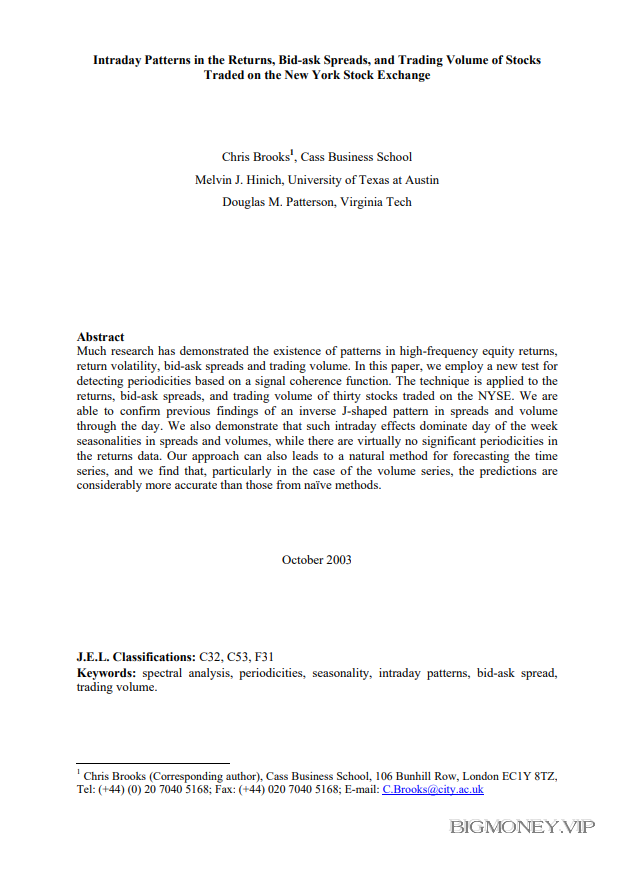Intraday Patterns in the Returns, Bid-ask Spreads, and Trading Volume of Stocks Traded on the New York Stock Exchange

1. Introduction
One of the virtually indisputable stylised features of financial time series is that they exhibit
periodicities, or systematically recurring seasonal patterns. Such patterns have been observed
in returns, return volatility, bid-ask spreads and trading volume, and significant effects appear
to be present at various frequencies. Early research employed daily or weekly data and was
focused on examining the returns themselves, including French (1980), Gibbons and Hess
(1981), and Keim and Stambaugh (1984). All three studies found that the average market
close-to-close return on the New York Stock Exchange (NYSE) is significantly negative on
Monday and significantly positive on Friday. Moreover, Rogalski (1984), and Smirlock and
Starks (1986) observed that this negative return between the Friday close and Monday close
for the Dow Jones Industrial Average (DJIA) occurs on Monday itself during the 1960's but
moves backward to the period between the Friday close and Monday open in the late 1970's.
By contrast, Jaffe and Westerfield (1985) found that the lowest mean returns for the Japanese
and Australian stock markets occur on Tuesdays. Harris (1986) also examined weekly and
intraday patterns in stock returns and found that most of the observed day-of-the-week effects
occur immediately after the open of the market, with a price drop on Mondays on average at
this time and rises on all other weekdays; see also Wood, McInish and Ord (1985).
Research has additionally employed intradaily data in order to determine whether there are
periodically recurring patterns at higher frequencies. Wood et al. (1985), for example,
examine minute-by-minute returns data for a large sample of NYSE stocks. They find that
significantly positive returns are on average earned during the first 30 minutes of trading and
at the market close, a result echoed by Ding and Lau (2001) using a sample of 200 stocks
from the Stock Exchange of Singapore. An extensive survey of the literature on intraday and
intraweek seasonalities in stock market indices and futures market contracts up to 1989 is
given in Yadav and Pope (1992).
More recent studies have also observed periodicities in bid-ask spreads and trading volume.
Chan, Chung and Johnson (1995), for example, investigate bid-ask spreads for CBOE stock
options and for their underlying assets traded on the NYSE. They obtain the familiar U-shape
spread pattern for the stock spreads, as McInish and Wood (1992) and Brock and Kleidon
(1992) had argued previously, but the option spreads are wide at the open and then fall
rapidly, remaining flat through the day. A large spread at the open that falls and then remains
constant for the remainder of the day was also found by Chan, Christie and Schultz (1995) in
their examination of stocks traded on the NASDAQ. The differences in results between the
NYSE and the NASDAQ / CBOE has been attributed to their differing market structure, the
NYSE having specialists while the NASDAQ is a dealer market. Finally, Jain and Joh (1988)
employ hourly aggregated volume for all NYSE stocks and observe that a U-shaped pattern is
also present in trading volume. This result is corroborated by Foster and Viswanathan (1993)
using volume data on individual NYSE stocks.
Many theoretical models of investor and market behaviour have also been proposed to
explain these stylised features of financial time series, including those that account for the
strategic behaviour of liquidity traders and informed traders (see, for example, Admati and
Pfleiderer, 1988). An alternative method for reconciling a finding of recurring seasonal
patterns in financial markets with the notion of efficient markets is the possible existence of
time-varying risk-premia, implying that expected returns need not be constant over time, and
could vary in part systematically without implying market inefficiency.
Traditionally, studies concerned with the detection of periodicities in financial time series
would either use a regression model with seasonal dummy variables (e.g., Chan, Chung and
Johnson, 1995) or would apply spectral analysis to the sample of data (e.g. Bertoneche, 1979;
Upson, 1972). Spectral analysis may be defined as a process whereby a series is decomposed
into a set of mutually orthogonal cyclical components of different frequencies. The spectrum,
a plot of the signal amplitude against the frequency, will be flat for a white noise process, and
statistically significant amplitudes at any given frequency are taken to indicate evidence of
periodic behaviour. In this paper, we propose and employ a new test for detecting
periodicities in financial markets based on a signal coherence function. Our approach can be
applied to any fairly large, evenly spaced sample of time series data that is thought to contain
periodicities. A periodic signal can be predicted infinitely far into the future since it repeats
exactly in every period. In fact, in economics and finance as in nature, there are no truly
deterministic signals and hence there is always some variation in the waveform over time.
The notion of partial signal coherence, developed in this paper into a statistical model, is a
measure of how much the waveform varies over time. The coherence measures calculated are
then employed to hone in on the frequency components of the Fourier transforms of the
signal that are the most stable over time. By retaining only those frequency components




